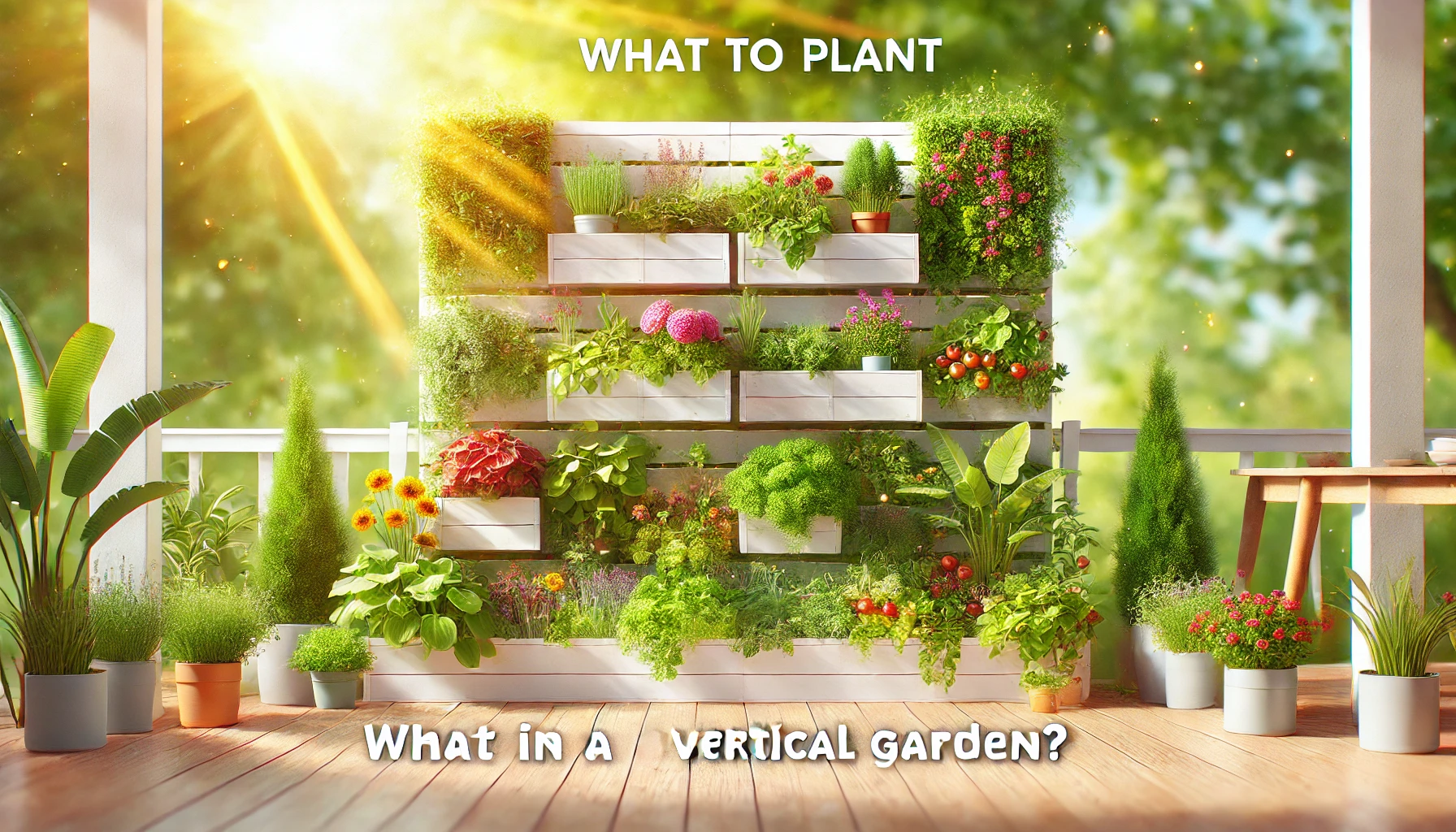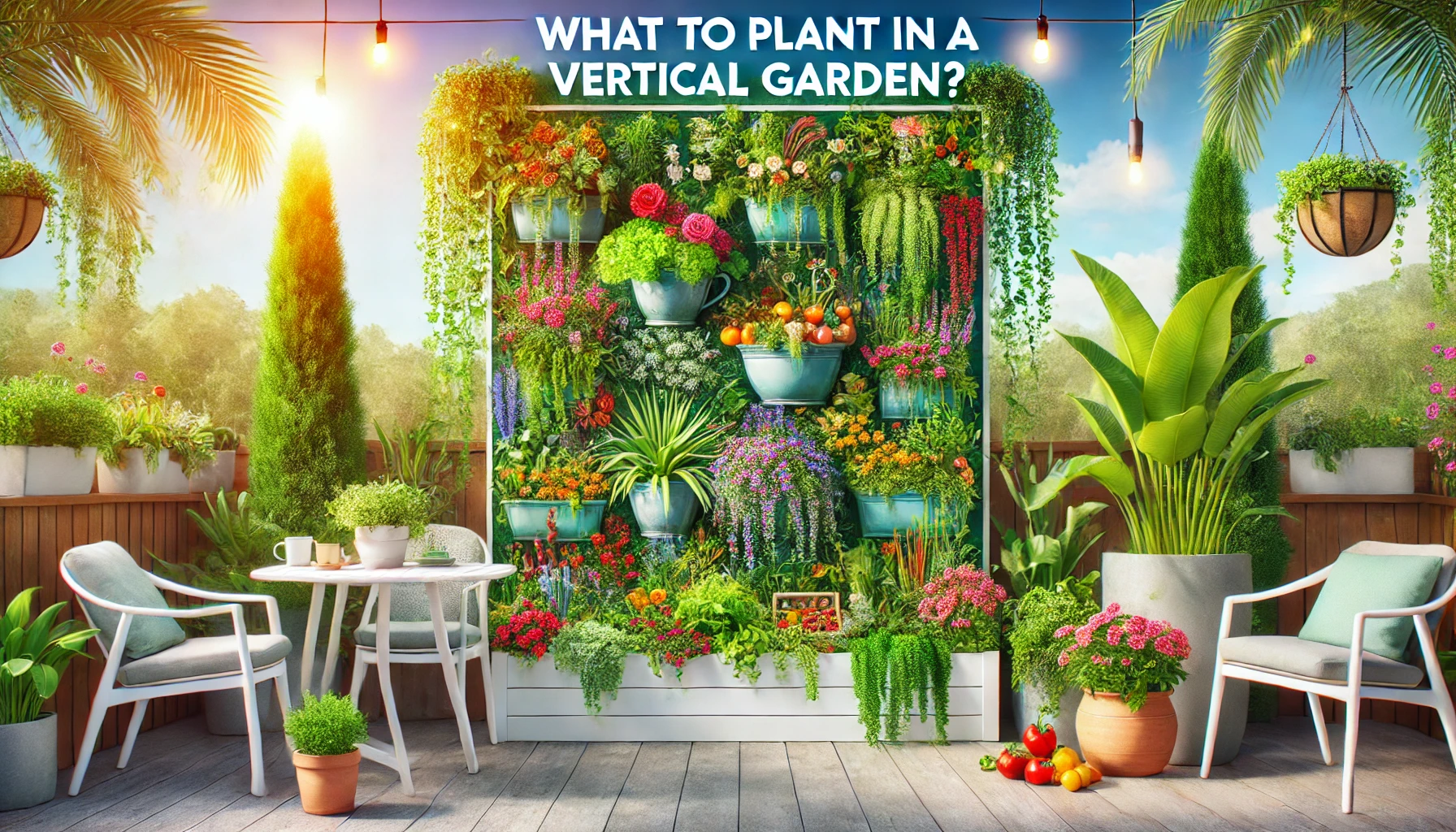Vertical gardening is an innovative way to maximize space while adding aesthetic appeal to homes, offices, or outdoor environments. Whether you’re a seasoned gardener or just starting, the concept of growing plants vertically opens up a world of possibilities for small spaces or enhancing your gardening experience.
Let’s delve into what you can grow in a vertical garden, including the best plants and vegetables, the pros and cons, and tips for getting the most out of your vertical planters.
What Plants Are Good for Vertical Gardens?
When it comes to vertical gardening, choosing the right plants is crucial to ensure a thriving and visually pleasing setup. The type of plants you select should align with the design, lighting, and purpose of your vertical garden.
1. Climbing Plants
Climbing plants are naturally suited for vertical gardens as they grow upward, needing minimal support:
- English Ivy: An excellent choice for covering large spaces, providing lush greenery.
- Clematis: Known for its vibrant flowers that bring color to any vertical garden.
- Wisteria: A beautiful option for outdoor vertical setups with cascading purple blossoms.
2. Trailing Plants
Trailing plants create a cascading effect, softening the overall look:
- Pothos (Devil’s Ivy): Hardy and low-maintenance, perfect for indoor vertical gardens.
- String of Pearls: Adds a unique texture with its bead-like foliage.
- Ferns: Boston ferns, in particular, are great for adding lush greenery.
3. Succulents
Succulents are ideal for vertical gardens due to their low water needs and compact size:
- Echeveria: Offers a variety of colors and shapes.
- Sedum: Hardy and drought-resistant, great for sunny spots.
- Hens and Chicks: A classic choice for a vibrant and resilient display.
4. Herbs
Growing herbs in a vertical garden is both practical and aesthetic:
- Basil: A staple for culinary use.
- Mint: Thrives in shaded areas and adds fragrance.
- Thyme: Compact and aromatic, perfect for small planters.
5. Ornamental Plants
Ornamental plants add a decorative element to vertical gardens:
- Begonias: Known for their bright, eye-catching flowers.
- Coleus: Features colorful foliage in various patterns.
- Marigolds: A vibrant addition to any vertical setup.
What Vegetables Grow Best in Vertical Gardens?
Vertical gardens aren’t just for aesthetic purposes; they’re also highly functional for growing vegetables. Here are some vegetables that thrive in vertical setups:
1. Leafy Greens
Leafy greens are compact, grow quickly, and thrive in vertical gardens:
- Lettuce: Perfect for beginners and grows rapidly.
- Spinach: Easy to grow and packed with nutrients.
- Kale: Hardy and suitable for most climates.
2. Climbing Vegetables
These vegetables naturally grow upwards, making them ideal for vertical gardens:
- Tomatoes: Cherry tomatoes, in particular, grow well vertically.
- Cucumbers: Provide a high yield when supported properly.
- Pole Beans: Easy to train and prolific producers.
3. Root Vegetables
Some root vegetables can adapt to vertical planters with sufficient depth:
- Radishes: Quick-growing and require little space.
- Carrots: Choose shorter varieties for better results.
- Beets: Grow well in deep pockets of vertical planters.
4. Herbs and Aromatics
Besides the herbs listed earlier, consider these additions:
- Parsley: A versatile herb for cooking.
- Cilantro: Perfect for fresh salads and salsas.
- Chives: Adds a mild onion flavor to dishes.
5. Peppers
Compact varieties of peppers, like bell peppers and chili peppers, flourish in vertical gardens.
Are There Any Drawbacks to Using Vertical Gardens?
While vertical gardening has numerous benefits, it’s essential to consider some potential drawbacks to make informed decisions.
1. Limited Plant Choices
Not all plants are suited for vertical gardens. Larger plants with deep root systems may struggle in compact spaces.
2. Irrigation Challenges
Watering a vertical garden can be tricky, as water tends to flow downward, leaving the upper plants under-watered and the lower ones over-watered.
3. Structural Support
Depending on the size and weight of your garden, you may need robust structures to hold the planters and plants securely.
4. Maintenance
Vertical gardens often require more frequent maintenance, including pruning, watering, and pest control, due to their compact nature.
5. Cost
The initial setup of a vertical garden, including planters, support systems, and irrigation, can be expensive.
What to Put in a Vertical Planter?
The success of your vertical garden depends not only on plant selection but also on the materials and soil used. Here are some essential tips for what to put in your vertical planters:
1. Quality Soil
Invest in nutrient-rich, well-draining soil to provide your plants with the best environment for growth.
2. Compost
Adding compost enhances soil fertility and promotes healthy plant growth.
3. Mulch
Use mulch to retain moisture and regulate temperature, especially in outdoor vertical gardens.
4. Lightweight Planters
Opt for lightweight planters made of materials like plastic or fabric to reduce strain on your vertical structure.
5. Proper Irrigation System
Install a drip irrigation system or self-watering planters to ensure even water distribution.
6. Fertilizers
Use slow-release fertilizers to supply consistent nutrients without overloading the plants.
Tips for Maintaining a Vertical Garden
Maintaining a vertical garden is essential to ensure its longevity and productivity. Here are some practical tips:
- Regular Pruning Trim overgrown plants to prevent overcrowding and ensure adequate airflow.
- Monitor Sunlight Position your vertical garden to receive the appropriate amount of sunlight based on the plants’ needs.
- Check for Pests Inspect your plants regularly for pests and take prompt action to prevent infestations.
- Rotate Plants Rotating plants periodically helps distribute sunlight evenly and encourages uniform growth.
- Replenish Soil Replace or replenish soil annually to maintain its fertility and structure.

Advanced Tips for Vertical Gardening
To take your vertical gardening to the next level, consider the following advanced techniques and strategies:
1. Hydroponic Vertical Gardening
Hydroponics involves growing plants in a nutrient-rich water solution instead of soil. This technique is highly efficient and suitable for small spaces.
- Benefits: Faster growth, better control over nutrients, and reduced pests.
- Best Plants: Leafy greens, herbs, and strawberries thrive in hydroponic systems.
2. Companion Planting
Pairing plants that complement each other can boost growth and reduce pests:
- Examples: Plant tomatoes with basil to enhance flavor and repel pests.
- Benefits: Maximizes space and improves plant health.
3. Vertical Garden Lighting
For indoor vertical gardens, adequate lighting is crucial:
- Grow Lights: LED grow lights are energy-efficient and mimic natural sunlight.
- Placement: Position lights to cover all plants evenly.
4. Seasonal Planting
Rotate plants seasonally to keep your vertical garden productive year-round:
- Spring: Focus on leafy greens and herbs.
- Summer: Grow tomatoes, cucumbers, and peppers.
- Fall: Switch to cool-weather crops like kale and spinach.
- Winter: Consider indoor plants or hardy vegetables like Swiss chard.
5. DIY Vertical Garden Projects
Create cost-effective vertical gardens using recycled materials:
- Pallet Gardens: Use wooden pallets as a framework for planting.
- Hanging Gardens: Repurpose old bottles or pots to create a hanging garden.
- Wall Planters: Install pockets or modular systems on walls for an easy DIY setup.
Benefits of Vertical Gardening
Vertical gardening offers numerous advantages beyond aesthetics. Let’s explore the key benefits:
1. Space Efficiency
- Small Footprint: Ideal for urban environments or homes with limited space.
- Maximized Yield: Grow more plants per square foot compared to traditional gardening.
2. Enhanced Aesthetics
- Visual Appeal: Creates a green, vibrant focal point in any space.
- Customizable Designs: Tailor the garden to your style and preferences.
3. Improved Air Quality
Plants naturally filter air, reducing pollutants and improving indoor air quality.
4. Accessibility
Vertical gardens are easier to maintain, as they reduce the need for bending or kneeling.
5. Environmental Benefits
- Reduced Heat: Vertical gardens can insulate walls and reduce urban heat.
- Water Conservation: Drip irrigation systems minimize water waste.
Common Mistakes in Vertical Gardening
Avoid these pitfalls to ensure the success of your vertical garden:
- Overcrowding Planting too many plants can lead to poor airflow and increased competition for nutrients.
- Inadequate Support Ensure your vertical garden structure can handle the weight of plants, soil, and water.
- Ignoring Light Requirements Choose plants that match the light conditions of your space.
- Neglecting Maintenance Regularly water, prune, and inspect your garden to keep it healthy.
- Using Poor-Quality Soil Low-quality soil can lead to poor growth and pest issues.
Expanding Vertical Gardens for Larger Yields
1. Incorporate Multiple Layers
Adding layers to your vertical garden can dramatically increase planting space. Modular systems or stacked planters are excellent for achieving this without compromising on space.
2. Combine Vertical with Horizontal Planting
Incorporate horizontal planters at the base of your vertical setup for plants that may need more root space or a different growing environment. This maximizes utility and diversity in your garden.
3. Utilize Smart Irrigation
Modern vertical gardens can benefit from smart irrigation systems that allow you to automate watering schedules based on weather conditions, plant type, and soil moisture levels. Smart technology ensures efficiency and reduces water waste.
4. Grow Seasonal Crops in Rotation
Plan your garden around crop rotation schedules to keep yields high and soil nutrients balanced. For instance, follow leafy greens with nitrogen-fixing crops like beans.
Conclusion
Vertical gardening is a creative and practical solution for maximizing space while enjoying the benefits of greenery. By carefully selecting plants, vegetables, and materials, and understanding the potential challenges, you can create a thriving vertical garden that suits your needs and enhances your environment.
Whether for aesthetic appeal, growing fresh produce, or both, vertical gardening is an innovative approach that continues to gain popularity among gardening enthusiasts worldwide. With proper planning, care, and creativity, your vertical garden can become a stunning and productive feature in your home or outdoor space.


Vertical gardening offers a dynamic and space-efficient way to bring greenery into compact spaces, making it a popular choice for urban dwellers and gardening enthusiasts alike. Herman’s article provides a comprehensive guide to selecting plants for vertical gardens, covering options ranging from climbing and trailing plants to herbs, succulents, and even vegetables.
The emphasis on matching plant types with garden conditions, such as lighting and structural support, is particularly valuable. For instance, the suggestion of climbing plants like wisteria or practical vegetables like cherry tomatoes highlights the versatility of vertical gardening. The inclusion of maintenance tips, such as proper irrigation and seasonal planting, ensures that readers are equipped to address common challenges.
However, the article also realistically acknowledges potential drawbacks, such as irrigation difficulties and the cost of setup, allowing readers to make informed decisions. Advanced techniques, like hydroponic gardening and companion planting, add depth to those looking to optimize their gardening efforts.
Overall, the article strikes a balance between inspiration and practicality, offering actionable advice for creating thriving vertical gardens. It underscores this innovative gardening approach’s environmental, aesthetic, and functional benefits and encourages readers to transform limited spaces into lush, productive green areas.
Thank you for such a thoughtful and detailed response! I’m thrilled that you found the article comprehensive and balanced. Vertical gardening indeed offers so much versatility, and I’m glad the inclusion of diverse plant options and practical advice resonated with you. Addressing challenges like irrigation and setup costs is essential for helping readers make well-informed decisions, and it’s great to hear that this aspect stood out.
Your acknowledgment of the advanced techniques like hydroponics and companion planting is especially encouraging—it’s an area I’m passionate about sharing to help gardeners maximize their efforts. Thank you again for your kind words and insights; I hope this inspires even more people to embrace vertical gardening!